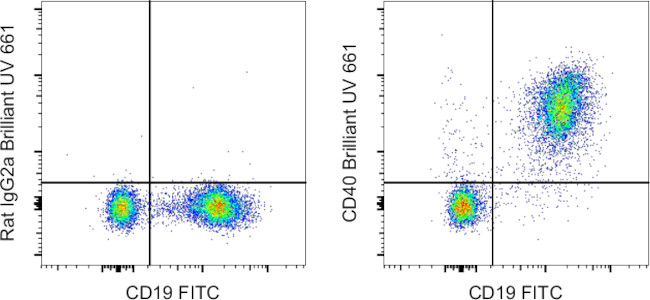Search Thermo Fisher Scientific
Invitrogen
CD40 Monoclonal Antibody (1C10), Brilliant Ultra Violet™ 661, eBioscience™
FIGURE: 1 / 1
CD40 Antibody (376-0401-82) in Flow

Product Details
376-0401-82
Species Reactivity
Host/Isotype
Recommended Isotype Control
Class
Type
Clone
Conjugate
Excitation/Emission Max
Form
Concentration
Purification
Storage buffer
Contains
Storage conditions
Shipping conditions
Product Specific Information
Description: The 1C10 monoclonal antibody reacts with mouse CD40, a 45-50 kDa type I transmembrane glycoprotein. CD40 is a member of the TNFR family and is expressed by mouse B lymphocytes, follicular dendritic cells, thymic epithelium, and a subset of peripheral T cells. CD40 regulates B cell development/maturation by inducing Ig isotype switching and in combination with other signals such as IL-4, protects B cells from surface Ig-induced apoptosis and promotes proliferation. Interaction of CD40 with CD154 (gp39), its ligand on T cells, is important in T-B cell crosstalk and plays a role in costimulation and immune regulation.
The monoclonal antibody 1C10 is reported to be agonistic in vitro and in vivo.
Applications Reported: This 1C10 antibody has been reported for use in flow cytometric analysis.
Applications Tested: This 1C10 antibody has been tested by flow cytometric analysis of mouse splenocytes. This may be used at less than or equal to 0.5 µg per test. A test is defined as the amount (µg) of antibody that will stain a cell sample in a final volume of 100 µL. Cell number should be determined empirically but can range from 10^5 to 10^8 cells/test. It is recommended that the antibody be carefully titrated for optimal performance in the assay of interest.
Brilliant Ultra Violet™ 661 (BUV661) is a tandem dye that emits at 660 nm and is intended for use on cytometers equipped with an ultraviolet (355 nm) laser. Please make sure that your instrument is capable of detecting this fluorochrome.
When using two or more Super Bright, Brilliant Violet™, Brilliant Ultra Violet™, or other polymer dye-conjugated antibodies in a staining panel, it is recommended to use Super Bright Complete Staining Buffer (Product # SB-4401-42) or Brilliant Stain Buffer™ (Product # 00-4409-75) to minimize any non-specific polymer interactions. Please refer to the datasheet for Super Bright Staining Buffer or Brilliant Stain Buffer for more information.
Light sensitivity: This tandem dye is sensitive to photo-induced oxidation. Please protect this vial and stained samples from light.
Fixation: Samples can be stored in IC Fixation Buffer (Product # 00-8222-49) (100 µL of cell sample + 100 µL of IC Fixation Buffer) or 1-step Fix/Lyse Solution (Product # 00-5333-54) for up to 3 days in the dark at 4°C with minimal impact on brightness and FRET efficiency/compensation. Some generalizations regarding fluorophore performance after fixation can be made, but clone-specific performance should be determined empirically.
Excitation: 350 nm; Emission: 660 nm; Laser: Ultraviolet Laser.
BRILLIANT ULTRA VIOLET™ is a trademark or registered trademark of Becton, Dickinson and Company or its affiliates, and is used under license. Powered by Sirigen.™
Target Information
The CD40 antigen is a single chain glycoprotein that is known to be a member of the tumor necrosis factor/nerve growth factor superfamily and shows a significant homology to the Hodgkin's disease associated antigen, CD30. CD40 is present on all B cells except plasma cells and is also found on some epithelial cells, carcinomas and lymphoid dendritic cells. CD40 has been found to be essential in mediating a broad variety of immune and inflammatory responses including T cell-dependent immunoglobulin class switching, memory B cell development, and germinal center formation. AT-hook transcription factor AKNA is reported to coordinately regulate the expression of CD40, which may be important for homotypic cell interactions. Adaptor protein TNFR2 interacts with CD40 and serves as a mediator of the signal transduction. The interaction of CD40 and its ligand is found to be necessary for amyloid-beta-induced microglial activation, and thus is thought to be an early event in Alzheimer disease pathogenesis. Two alternatively spliced transcript variants of CD40 encoding distinct isoforms have been reported. Diseases associated with CD40 dysfunction include Type 3 Hyper-Igm immunodeficiency and CD40 ligand deficiency.
For Research Use Only. Not for use in diagnostic procedures. Not for resale without express authorization.
How to use the Panel Builder
Watch the video to learn how to use the Invitrogen Flow Cytometry Panel Builder to build your next flow cytometry panel in 5 easy steps.
References (0)
Bioinformatics
Protein Aliases: B-cell surface antigen CD40; Bp50; CD antigen CD40; CD40; CD40L receptor; Immunoglobulin M; ImmunoglobulinM; MGC9013; sCD40; soluble CD40; T-cell differentiation antigen; Tumor necrosis factor receptor superfamily member 5; tumor necrosis factor receptor superfamily, member 5
Gene Aliases: AI326936; Bp50; Cd40; GP39; HIGM1; IGM; IMD3; p50; T-BAM; Tnfrsf5; TRAP
UniProt ID: (Mouse) Q99NE2
Entrez Gene ID: (Mouse) 21939

Performance Guarantee
If an Invitrogen™ antibody doesn't perform as described on our website or datasheet,we'll replace the product at no cost to you, or provide you with a credit for a future purchase.*
Learn more
We're here to help
Get expert recommendations for common problems or connect directly with an on staff expert for technical assistance related to applications, equipment and general product use.
Contact tech support

